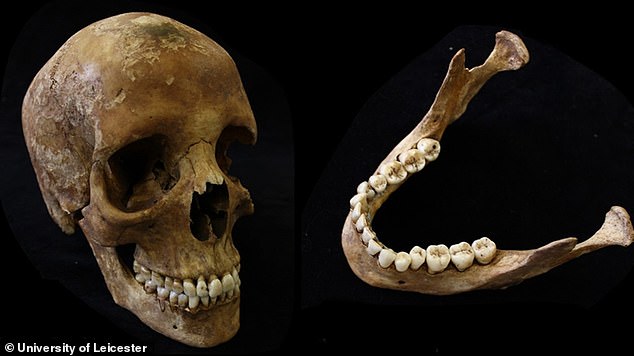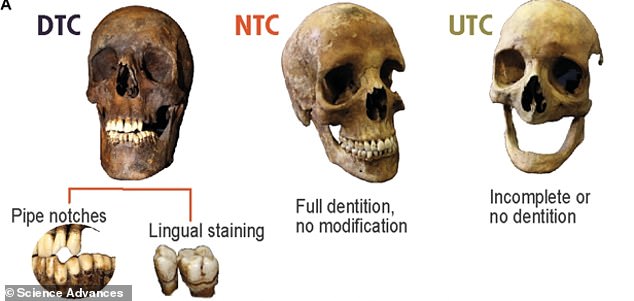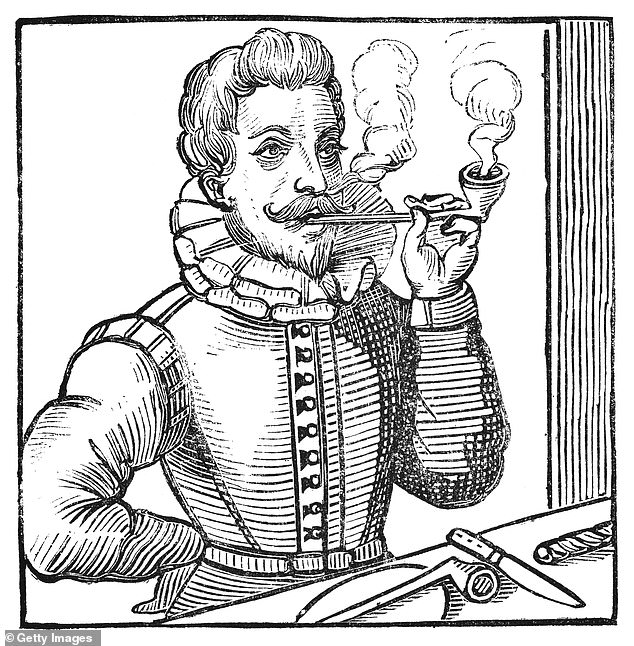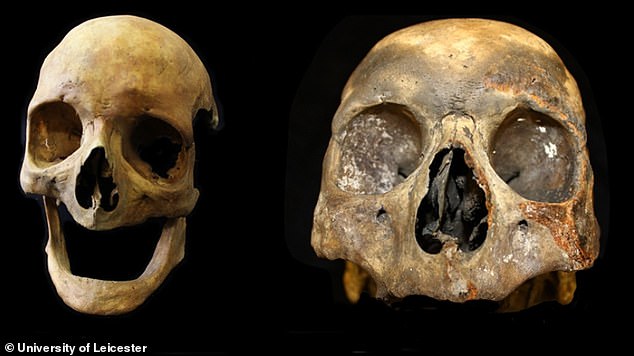Shocking images reveal what smoking does to your BONES as scientists discover cigarettes change their molecular make-up FOREVER
From lung cancer to heart disease and chronic bronchitis, the effects of cigarette smoking are well documented.
But a new study warns that the risky habit can leave marks in your bones even centuries after death.
Researchers from the University of Leicester studied human remains buried in England between 1150 and 1855.
This timeline effectively limits the arrival of tobacco to Western Europe in the 16th century – an act usually attributed to Sir Walter Raleigh in 1586.
They discovered that smoking not only stains and dents your teeth, but also leaves small chemical molecules in your teeth – which may stay there forever.
Scientists can tell whether a deceased person has smoked by looking at stains or stains on the teeth. For example, dents known as ‘pipe nicks’ are said to have been formed by a tobacco pipe, while ‘lingual spots’ are black or brown spots on the part of the tooth surface that faces the tongue.

Experts examined 323 sets of skeletons uncovered in two graves in England, some of whom were determined to have smoked tobacco
In the study, the experts wanted to learn more about these molecules and the effect they could have on modern human health.
‘Our research shows that there are significant differences in the molecular signatures in the bone of former tobacco users and non-users,’ said lead author Dr Sarah Inskip, a bioarchaeologist.
‘This may show that we can see the impact that tobacco use has on the structure of our skeletons.’
In general, scientists can quite easily determine whether a deceased person from hundreds of years ago smoked due to stains or stains on the teeth.
For example, round dents known as ‘pipe nicks’ are gradually formed by a tobacco pipe mouthpiece.
Many centuries ago, tobacco pipes were made of clay and were thus harder than today’s cigarettes, although such dents could be made possible by today’s plastic vapes.
Meanwhile, “lingual discoloration” – black or brown spots on the part of the tooth surface facing the tongue – is caused by smoke circulating in the mouth and exhaled.
However, sometimes a skeleton’s teeth do not survive or become separated from the rest of the body and are lost, making it more difficult, but not impossible, to determine whether or not the person has smoked.
The scientists have developed a method that looks for molecular traces of tobacco smoke in the cortical bone – the dense tissue that forms the outer layer of bones and provides bone strength.

The researchers studied bones from detected tobacco consumers (DTCs) and undetected tobacco consumers (NTCs). Many archaeological individuals have poorly preserved dental remains or lose their teeth before death, causing them to be categorized as indeterminate tobacco consumers (UTCs).

A common date for the arrival of tobacco in England is July 27, 1586, when Sir Walter Raleigh is said to have brought tobacco to England from Virginia. Pictured, a portrait of Sir Walter Raleigh smoking (c. 16th century)
They examined 323 sets of skeletons uncovered in two graves in England, some of whom were determined to have smoked tobacco.
The total included 177 adult individuals from St James’s Garden Burial Ground in Euston, London, dating from the 18th and 19th centuries.
The remaining 146 people were taken from a rural church cemetery in Barton-upon-Humber in Lincolnshire.
Remains at Barton-upon-Humber include those who lived before the introduction of tobacco to Europe (1150-1500 AD) and those who lived after (1500-1855 AD).
By analyzing human skeletal remains from both before and after tobacco was introduced to Western Europe, researchers were able to ‘clearly’ identify bone changes.
The team identified 45 ‘distinctive molecular features’ that differed between tobacco smokers and non-smokers.
Furthermore, the team was able to determine whether previously ‘indeterminate’ skeletons were smokers or not, by identifying molecular similarities between them and the known smokers.
“Tobacco consumption leaves a metabolic record in human bone that is distinctive enough to identify its use in individuals with unknown tobacco consumption,” the team says in their paper, published in Scientific progress.

Sometimes a skeleton’s teeth do not survive or become separated from the rest of the body and are lost, preventing a simple judgment as to whether or not that person smoked

From lung cancer to heart disease and chronic bronchitis, the deadly consequences of cigarette smoking are rightly well documented (file photo)
Overall, the study shows that tobacco consumption leaves a metabolic record in human cortical bone even hundreds of years after death.
This may be important to understand why tobacco use is a risk factor for some musculoskeletal and dental diseases.
“This groundbreaking research shows that archaeo-metabolomics has much to offer when it comes to understanding past phenotypes such as tobacco smoking,” they say.
‘[This] can help us better understand past health problems and their relationship to current trends.”
Looking ahead, the team wants to continue to gain a better understanding of how tobacco has affected the health of past populations since its popularity around the world.
Tobacco was introduced to Western Europe from America in the 16th century and has been present in England since the 1660s.
It is thought that sailors returning from Atlantic voyages led by English naval commander Sir John Hawkins brought it home after a voyage to Florida in 1565.

‘The Smoker Allegory of Transience’ by Hendrick van Someren, painted around 1615 to 1625, depicts an old man smoking a clay pipe
However, a more common date for the arrival of tobacco in England is July 27, 1586, when Sir Walter Raleigh is said to have brought tobacco to England from Virginia.
Smoking tobacco was said to have vast and varied medicinal properties, and its use became common in the 17th century.
This while James I of England and James VI of Scotland condemned the use of tobacco in 1604 because of its toxic effects on the body.
James wrote that smoking was a habit horrible to the eye, hateful to the nose, injurious to the brain, dangerous to the lungs, and in its black and fetid vapor, most resembling the terrible stygian. [very dark] smoke from the pit that is bottomless’.
